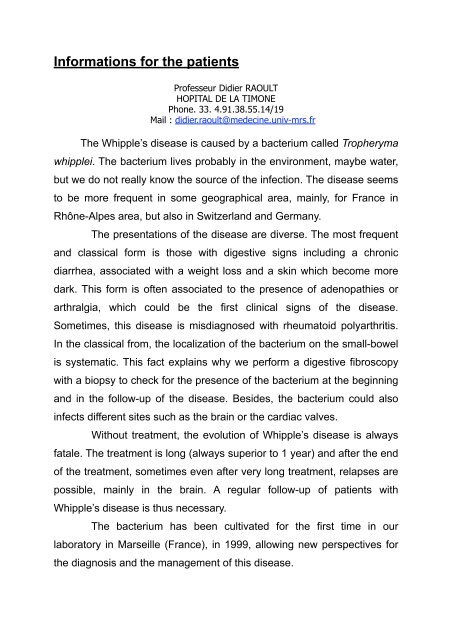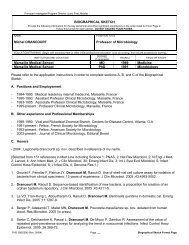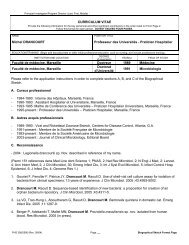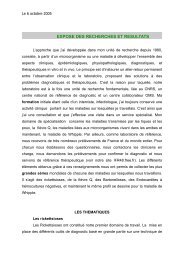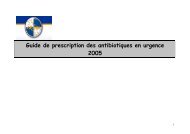Whipple's disease and Tropheryma whipplei
Whipple's disease and Tropheryma whipplei
Whipple's disease and Tropheryma whipplei
Create successful ePaper yourself
Turn your PDF publications into a flip-book with our unique Google optimized e-Paper software.
Informations for the patients<br />
Professeur Didier RAOULT<br />
HOPITAL DE LA TIMONE<br />
Phone. 33. 4.91.38.55.14/19<br />
Mail : didier.raoult@medecine.univ-mrs.fr<br />
The Whipple’s <strong>disease</strong> is caused by a bacterium called <strong>Tropheryma</strong><br />
<strong>whipplei</strong>. The bacterium lives probably in the environment, maybe water,<br />
but we do not really know the source of the infection. The <strong>disease</strong> seems<br />
to be more frequent in some geographical area, mainly, for France in<br />
Rhône-Alpes area, but also in Switzerl<strong>and</strong> <strong>and</strong> Germany.<br />
The presentations of the <strong>disease</strong> are diverse. The most frequent<br />
<strong>and</strong> classical form is those with digestive signs including a chronic<br />
diarrhea, associated with a weight loss <strong>and</strong> a skin which become more<br />
dark. This form is often associated to the presence of adenopathies or<br />
arthralgia, which could be the first clinical signs of the <strong>disease</strong>.<br />
Sometimes, this <strong>disease</strong> is misdiagnosed with rheumatoid polyarthritis.<br />
In the classical from, the localization of the bacterium on the small-bowel<br />
is systematic. This fact explains why we perform a digestive fibroscopy<br />
with a biopsy to check for the presence of the bacterium at the beginning<br />
<strong>and</strong> in the follow-up of the <strong>disease</strong>. Besides, the bacterium could also<br />
infects different sites such as the brain or the cardiac valves.<br />
Without treatment, the evolution of Whipple’s <strong>disease</strong> is always<br />
fatale. The treatment is long (always superior to 1 year) <strong>and</strong> after the end<br />
of the treatment, sometimes even after very long treatment, relapses are<br />
possible, mainly in the brain. A regular follow-up of patients with<br />
Whipple’s <strong>disease</strong> is thus necessary.<br />
The bacterium has been cultivated for the first time in our<br />
laboratory in Marseille (France), in 1999, allowing new perspectives for<br />
the diagnosis <strong>and</strong> the management of this <strong>disease</strong>.


